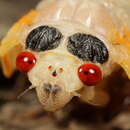en
names in breadcrumbs


Magicicada tredecim is known from Alabama, Arkansas, Georgia, Illinois, Indiana, Kentucky, Louisiana, Maryland, Missouri, Mississippi, North Carolina, Oklahoma, South Carolina, Tennessee, and Virginia (U.S.A.) (Sanborn & Phillips 2013).